
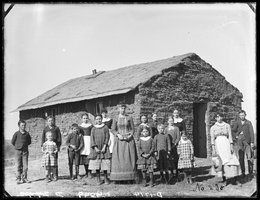
One of the first acts of the new Nebraska territorial legislature in 1855 was to provide for free public schools across the state, but life for children during the settlement period was probably centered less on school than it is now. The “Free Public School Act of 1855” created a territorial superintendent and provided for county school superintendents to be elected by popular vote. Each county superintendent was to organize school districts and levy a property tax to support the schools. But not every locale levied the taxes and built the schools, and economic slow downs might force local districts to close down. Schools were important, but sometimes the resources weren’t available to support a public school.
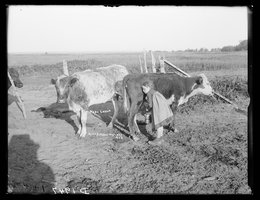
Also, not every child attended school. In 1860, only 30 percent of school-age children in Nebraska attended school. That figure rose as settlement continued — by 1870, 52 percent of Nebraska kids attended school. Nationally that year, 55 percent of school-age children attended.
Those who were able to go to school usually attended every day except for Sunday, from October to May. That way, they could be at home during the main planting and harvesting seasons. In fact, the current school year calendar — with classes during the fall, winter and spring — was designed so that students could attend to their agricultural duties in the summer. Only eight grades were taught, and usually you would have kids in all eight grades in one room of the schoolhouse. Students were frequently required to memorize their lessons, or write on slates.
In 1889, 70 percent of the Nebraskans lived on farms. Children were expected to help the adults with the farm work. Milking cows and gathering cow or buffalo chips for fuel in the cook stove was a duty for both girls and boys. Girls helped with the cooking, cleaning, mending, gathering eggs, and taking care of the younger children. Boys helped with the planting and harvesting of crops and also helped hunt for food to feed the family. Yet there was also time for fun.
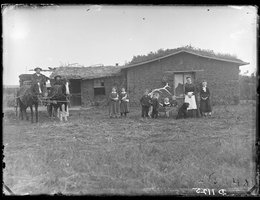
Did children on the frontier ever have the opportunity to play? Older kids took up the pastimes of grownups early. Younger kids had their toys. Some were homemade.
Here are some of the popular games played by Nebraska homestead children:
Button Button: The children sit in a semi-circle with palms of hands together. “It” holds a button between the palms of his hands and goes from one player to another passing his hands between those of the seated players finally leaving the button in someone’s hands. He continues the play after leaving the button so that the others will not know who has it. Then he says, “Button, button who has the button?” All the children guess, not waiting for turns, and the one who guesses correctly has the fun of passing the button next.
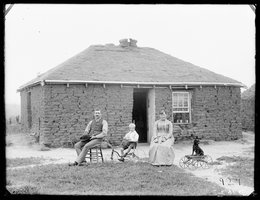
Fox and Geese: A large circle from 15 to 30 feet in diameter, usually made in the snow, is required for this game. Five paths or lines are made across the circle through the center. The circle can be made on a floor with chalk or on the bare ground with a stick. The "fox" stands in the middle of the circle and attempts to catch the geese when they venture away from an intersection. A "goose" may not turn back nor make an angle at the intersection. The "goose" who gets tagged becomes the "fox." A more complicated game is played with two circles, one within the other, in which the geese may turn at any intersection, and the geese are limited to one for each section of the circle.
Hunt the Thimble: One child sends all the others from the room, after which he places the thimble in an inconspicuous place in plain sight. He then calls the others into the room, and they begin to search for the thimble. As each one sees the thimble he says, "I spy" and sits down. If it is rather difficult to find, the one who hid it says "warm" when a searcher is near the thimble and "cold" when he goes away from it. After all have found it, the one who first saw it has the privilege of hiding it. Children especially enjoy this game when adults, working in the room where the thimble is hidden share their secret. The game may be varied by sending only one child or half the children from the room while the others hide the thimble. Then the group who hid the thimble sing some song and as a searcher gets nearer or further from the thimble, the music gets softer or louder. The game is also known as "Hide the Thimble," and "I Spy."
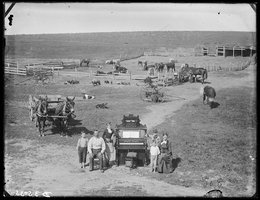
In 2001, David Hilton’s great grandson Scott Kaelin wrote,
"Why did they have such an ornate musical instrument when they still lived in a primitive dirt house? You see, David was born in Manchester, England and was educated in music before coming to America at the age of 25. He was a musician and music was very important to him. ... The Hiltons had a quartet: Emma played the organ and sang soprano; Lydia sang alto; Leonard sang tenor; and George had a deep bass voice. They sang at church, for funerals and for many other community activities."
There were recreational activities for adults as well. Some settlers brought the family organ, piano, melodeon or other instruments to their new homes. With no radios, recordings — let alone TVs — entertainment was most often homemade, and the ability to make music meant that neighbors from all over the surrounding countryside would visit for songfests, dances or religious services.
What did children living on the frontier do on a daily basis? Would their activities be different
than your activities today?
What toys did children living on the frontier have? How would your toys be different?
Compare and contrast toys for boys and girls during the mid and late 1800s with toys for boys and girls today.
What inferences could you draw about life on the frontier for children based on the primary
source documents in this collection?